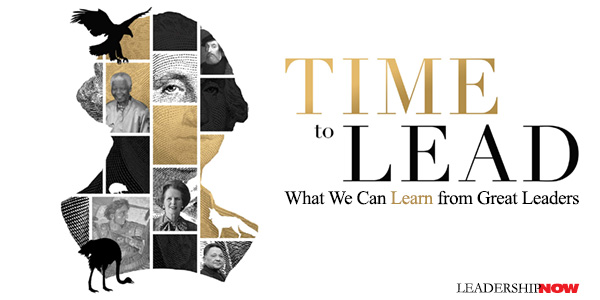 |
 |
09.18.20

Time to Lead: What We Can Learn from Great Leaders
AS professor Jan-Benedict Steenkamp states in Time to Lead, “Everybody can improve their leadership qualities by reading about other leaders, how they resolved their dilemmas, and why they were successful.” Peter Drucker was asked whether he considered himself more of a historical writer or a management thinker: “More a historical writer,” Drucker answered. He explained that the human being has changed relatively little during the known course of history. We therefore gain more valuable leadership insights from historical analogies and examples than by embracing the latest management fads. A quick survey of the world today would suggest that historical knowledge and the lessons we can learn from it, is critically lacking. Steenkamp begins to shore up that deficiency, by looking at the lives of 16 men and women and the decisions they were faced with that changed the course of history. He analyses each in terms of three dimensions. First, he looks for seven leadership traits: Intelligence, Self-Confidence, Integrity, Sociability, Emotional Intelligence, Humility, and Grit. The leaders in the book differed greatly in this area. While some showed no sign of some of these traits, they all demonstrated a high degree of grit or determination. Second, he identifies four types or leadership metaphors: the hedgehog, the fox, the eagle, and the ostrich. Developed from Isaiah Berlin’s expose of the Greek poet Archilochus statement that “the fox knows many smaller things, but the hedgehog knows one big thing.” He writes, “According to Berlin, the distinction between hedgehogs and foxes marks ‘one of the deepest differences, which divide … human beings.’”
Hedgehogs “know much better where they are going (ends) than how to get there (means).” They are guided by a single long-term vision, seeing the forest rather than the trees. On the other hand, foxes “know much better how to get somewhere (means) than where they are going (ends). They are operation rather than strategic leaders.” (As a side note, all of the leaders profiled with the exception of Campbell-Bannerman, exhibited strong hedgehog qualities. However, all were eagles because, in time, they were able to align their means with goals.) Eagles are a combination of the hedgehog and the fox. They “know where they are going (ends) and how to get there (means).” While dealing with the trees they never lose sight of the forest. They are agile and adaptive. Ostriches have neither the qualities of the hedgehog or the fox. They “neither have a clear idea where they are going (ends) nor how to get there (means). Being clueless, they lack a compelling central vision. Next, Steenkamp looks at each leader in terms of seven leadership styles: Adaptive, Persuasive, Directive, Disruptive, Authentic, Servant, and Charismatic leadership. In the appendix of this book you will find three assessment tools: the Grit Scale, the Hedgefox Scale, and SAILS an assessment for leadership styles. Since the point of looking at these leaders live is to learn lessons that we can apply to our leadership today, he chose leaders that could be used to explain a certain leadership style, show the application of a leadership style in practice, prove the possibility of a leadership style across different circumstances, and leaders whose experiences he could derive general insights. In each of the seven leadership styles, he looks at the following leaders: Adaptive Leadership—Modify According to the Circumstances
Persuasive Leadership—Change the Minds of Your Followers
Directive Leadership—Define the Marching Orders
Disruptive Leadership—Break with The Past
Authentic Leadership—Set the Example
Servant Leadership—Put Followers First
Charismatic Leadership—Buy into the Leader, Then Follow Their Vision
All of these great leaders are human and struggle with the same kinds of things we all do. The stories of their lives and the decisions they were faced with are encouraging if only to show that you don’t have to be super-human to face your own critical moments. From these accounts you will see that no one style or set of traits will bring you leadership success. But by learning to understand these leaders in their times, you will begin to understand yourself better. 
Posted by Michael McKinney at 08:05 AM
|
BUILD YOUR KNOWLEDGE
 

How to Do Your Start-Up Right STRAIGHT TALK FOR START-UPS 
Grow Your Leadership Skills NEW AND UPCOMING LEADERSHIP BOOKS 
Leadership Minute BITE-SIZE CONCEPTS YOU CAN CHEW ON 
Classic Leadership Books BOOKS TO READ BEFORE YOU LEAD |